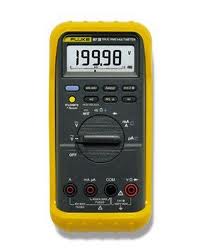Parasitic Draw Testing
Say you leave your vehicle sit for long periods of time and the battery goes dead. You’ve either checked or replaced both the battery and alternator, and you know they’re good. So what’s going on? You might have a parasitic draw.
A parasitic draw is an excessive electrical load on the system that happens after the vehicle is turned off. There will be some activity and loads when you turn your vehicle off, your clock circuit for one. In many modern vehicles, when you shut down and remove the key, a series of events happens that can draw current for several minutes after you turn the engine off. This is normal. To see if this is excessive and test for a parasitic draw, you’ll need a DVOM (Digital Volt Ohm Meter) capable of testing amps.
Often, when doing this test, you need to move your test leads on the DVOM to a different location when testing for amps, so be sure to check for this. It’s also important to note that you need to make sure everything is off when doing your testing. Don’t leave the trunk or any doors open, and make sure the key is removed from the ignition. This way you’re sure that there won’t be any electrical loads that you induced when doing this test that would give you false readings.
To perform the test: Remove the negative battery cable. Some people remove the positive cable to do this test, and that’s fine, but I recommend the negative cable when doing parasitic draw testing. Put your meter on the highest DC amp scale. This might require that you move your test lead to a special location on your DVOM. Place the leads in series between the negative cable and the negative battery post and take your measurement. If you see a negative number, switch the leads.
To be honest, it doesn’t matter, because the readings will be the same. You don’t want to see a reading above 50 milliamps. I know I told you to start with the highest scale, which might be close to 10 amps. If you don’t see a reading when you’re on the highest scale, great. You want to do it this way because some amp draws can be pretty high, which could damage your meter if you’re on a lower scale. If you don’t have a reading on the high scale, switch to the lower scale. Don’t forget to switch the leads if you need to. Once again, you’re looking for less than 50 milliamps. If you see a reading above 50 milliamps, your draw is excessive and it can drain the battery. The higher the reading, the faster the drain.
A couple of things to note: Some modern vehicles, especially luxury vehicles, have systems that remain on after the key has been removed and the doors have been closed. These systems might remain on for up to 30 minutes after shutdown. Keep this in mind when doing your testing. You might have to wait with your meter still hooked up for 30 minutes or more to get an accurate reading. Once you unhook the meter, things start all over again.
So you’ve done the test, you’ve waited an appropriate amount of time, and you’re still seeing above 50 milliamps. The next step is to start removing fuses one by one while observing the amp readings. If you see a sudden drop when removing a particular fuse, this is likely your culprit.
The next step after you find the offending fuse is to find a wiring diagram showing what’s on that circuit. After that, it’s a process of further elimination. Unplug each component in that fuse’s circuit till the draw goes away. For example, if the fuse controls the radio and power antenna, plug the fuse back in and unplug the antenna. If the draw goes away, you’ve narrowed it down to the power antenna. If it doesn’t go away, unplug the radio and recheck your reading. You’re probably getting the picture now. Here’s a video about parasitic draw testing you might find helpful.
Video Title: Parasitic Draw Testing – Solving Automotive Electrical Problems – EricTheCarGuy Video Description: In this Article we talk about Parasitic Draw Testing that you can do with Your vehicle. Thumbnail: http://www.ericthecarguy.com/images/faq_buttons/Large_FAQ_Images/Electrical-icon-1200.jpg
 Our Address
Our Address




6 thoughts on “Parasitic Draw Testing”
Niko
April 25, 2023 at 11:42 am
Good job on this video Eric!
jim neill
August 23, 2022 at 11:01 am
followed your utube for parasitic drain… I get zero drain…should get at least 50 mA. I get ZERO.
NEW Klein meter, NEW battery ?????????????
Wayne
December 28, 2022 at 1:58 pm
No, you just do not want “more than” 50mA
Robert Escoto
March 31, 2021 at 6:02 pm
Eric you did an outstanding job explaining the process to diagnose the parasitic draw. Thank you for sharing your knowledge with us who love to learn!
Alberto
July 3, 2020 at 7:33 pm
I have a 234 tester reading and I found the circuit. whenever I find and fix the circuit will I get same reading again (234)? HOw can I get the electric Diagram for Honda Oddyssey 2002
Ronald Lemoine
October 1, 2020 at 6:27 pm
I watched video and enjoyed it. My problem is what is process if you have 2 batteries. I have a ram 2500